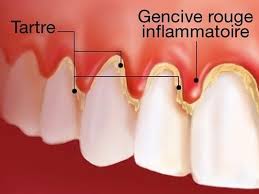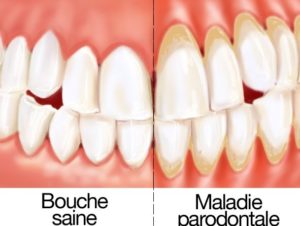Periodontology
Periodontology is concerned with the curative and preventive treatment of diseased gums. Periodontology can also have an aesthetic role in the harmonization of the teeth.
Periodontal disease
Periodontal disease is a disease that evolves slowly over time, in most forms, and will affect the gum and bone around the teeth. This is what makes this disease one of the most common diseases in the mouth of patients who are often completely unaware of it.
The periodontium represents all the tissues (bone, gum) around the teeth that will play the role of anchoring the tooth in the jaw.


Inflammation is caused by bacteria that are bad for the gums, which will develop when dental hygiene is not perfect, especially in the areas under the gums and between the teeth. These are bacteria that will live in areas deprived of oxygen, under the gums. They are therefore not cleaned with a toothbrush alone, which does not clean between the teeth and under the gums. In addition to the toothbrush, it is absolutely necessary to use an interdental hygiene method such as dental floss or interdental brushes to properly clean these subgingival areas, which are real reservoirs of pathogenic bacteria.

There is a significant genetic component in the transmission of this disease. Indeed, a patient may have a hereditary background that makes him/her more fragile and more prone to develop this type of disease.
Smoking is also an important risk factor for periodontal disease.

1st stage of the disease: Gingivitis
When the periodontium is diseased, it becomes inflammed; the gums turn red and bleeds easily, especially when brushing the teeth: these are the first symptoms that should alert the patient and motivate him to consult his dentist.


2nd stage of the disease: Periodontitis
If gingivitis is not treated in time and persists over time, the inflammation will grow and reach the bone around the teeth. The bone in response to the inflammation will resorb, and shrink around the teeth.
There are three stages to this periodontitis: early, moderate and severe.
This will lead to significant tooth loosening, and empty spaces will develop between the teeth because of the bone that will be lowered. The roots of teeth with less anchorage are then more prone to undergo dental migrations (these are teeth that move in the mouth), or even dental mobilities.
These are symptoms that can take time to alert the patient because they develop slowly over time, and often without pain. It is therefore up to the dentist to diagnose this during the check-ups and scaling that are performed every year.
3rd stage of the disease: Significant tooth mobility and tooth loss
This 3rd stage will mainly represent the terminal evolution of a severe periodontal disease not treated in time. Thus, when the loss of bone around the teeth has been too great, the teeth, which no longer have enough anchorage, can move very strongly or even fall out naturally.
At this point, a global treatment of the mouth and gums must be undertaken, and the missing teeth will then be replaced by prostheses or implants.
It is also scientifically proven that there are close links between periodontal disease and heart disease, and also with diabetes.

